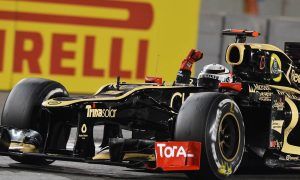
© F1i
DETAILED VERIFICATIONS
Looking at the rear of the red racing car, the winglet located in front of the rear brake air duct was replaced by a serrated version. Previously in one piece, the part now consists of three separate elements.
As seen above, green fluorescent paint was applied to the new winglet. Why ?
Aerodynamicists are well aware that wind tunnel and CFD (computational fluid dynamics) data are only pinpoint accurate in the virtual world! Indeed, nothing can replace on-track validation. This is why engineers will study how the air flows around the chassis and bodywork thanks to a fluorescent paint, called “flow viz paint” (for visualisation).
In practice, a paraffin-based light coat of paint is applied on selected parts of the bodywork engineers wish to investigate. When the car is running on track, the wind dries the paint and reveals how the fluorescent particles have been moved around the specific areas. Back in the closed garage, the team photographs – like the Scuderia’s engineer is doing here – the detailed air flow patterns across the car, their intensity, direction, areas where the flow may have ruptured, etc...
Once again, you compare the observations with the data you’ve gathered inside the wind tunnel and via CFD. As you can imagine, this is tedious, repetitive, and not really exhilarating work, but it remains vital if you want to lay solid foundations for the season ahead.






